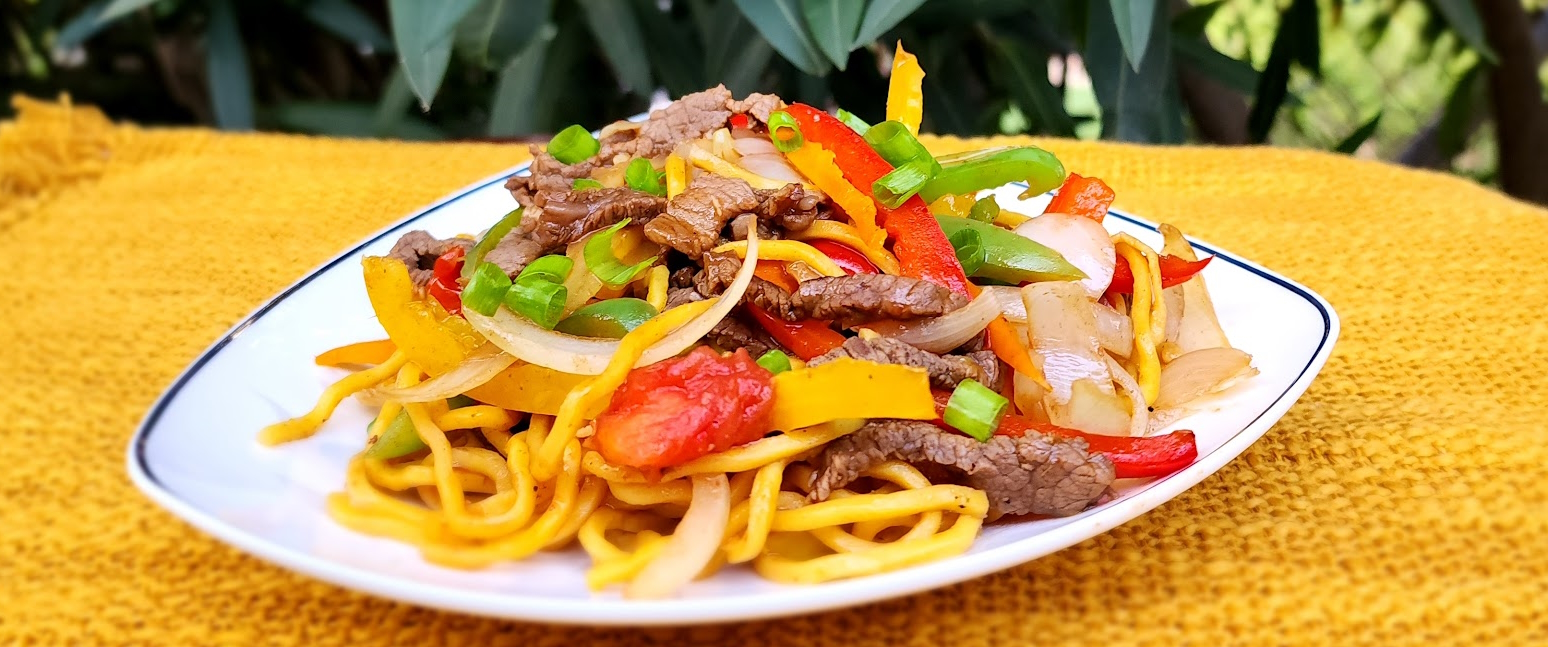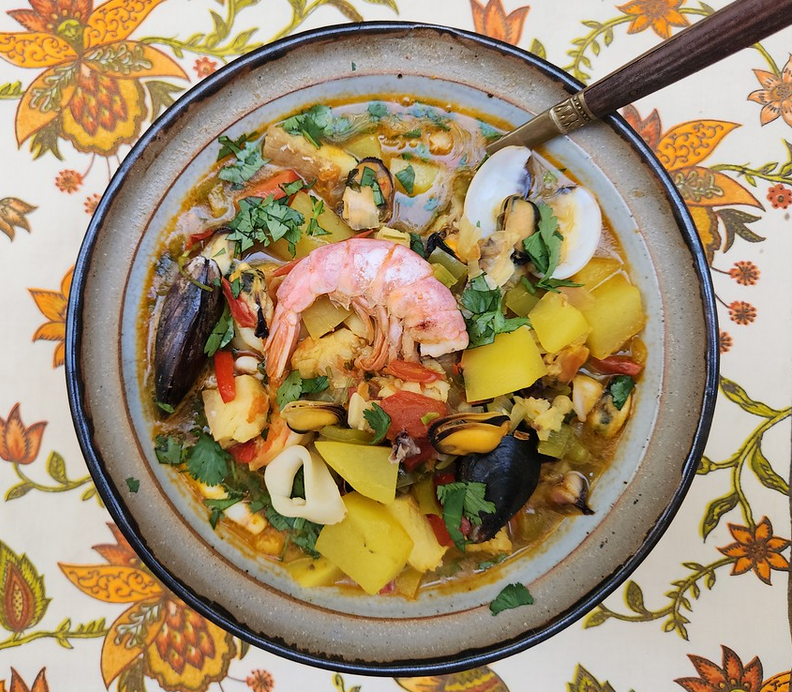The Participant Observer Recipe of the Month is for Tallarín Saltado Chifa, a Peruvian-Chinese stir-fry that combines flavors from Asia and South America. It is an extremely common dish offered by street food vendors and restaurants throughout Peru.

The term "mestizaje" refers to the blending of cultural traditions, and Tallarín Saltado Chifa embodies the spirit and meaning of this concept. Foods and eateries that blend Peruvian and Chinese cuisine are called "chifa", a term believed to have originated from the Cantonese phrase "chī fàn", meaning "to eat rice."
Slavery was abolished in Peru in 1854. As the transatlantic slave trade declined across South America, laborers were brought from Asia, with most of Peru's agricultural workers arriving from southern China. Like in North America, Chinese laborers also worked on building and maintaining railroads, often under conditions of indentured servitude or misled by false promises of better economic opportunities from unscrupulous agents. Naturally, Chinese immigrants brought with them their culinary habits and traditions. However, many of the foods and ingredients they were accustomed to were uncommon or nonexistent in Peru, so they adapted to what was locally available, as immigrants do in many places.
Tallarín Saltado Chifa is prepared in the style of a Chinese stir-fry. Several flavorings originate from Asia or are common ingredients there, such as soy sauce. These are combined with ingredients more associated with the Americas, such as ají amarillo (yellow chili pepper), tomatoes, and bell peppers. The Chinese immigrants also brought a preference for noodles and the Asian technique of stir-frying. "Tallarín" refers to the noodles in the dish, and "saltado" means "stir-fry." As noted above, "chifa" refers to Peruvian-Chinese cuisine in general.
While beef (sirloin) is the most common protein in Tallarín Saltado Chifa, chicken, pork, and shrimp can also be used. The most common noodles are thick, round Chinese egg noodles, though many recipes call for spaghetti noodles. In addition to the typical vegetables used in Tallarín Saltado Chifa—such as tomatoes, onions, and bell peppers—other vegetables like carrots, broccoli, snow peas, or bok choy can be included. For an extra touch of authenticity, you can add Peruvian ají amarillo (yellow peppers) to the dish. They add a very pleasant hotness to the dish. Aji amarillo, when fresh, are similar in heat to serrano chilies, but our impression was that the frozen ones are less hot. They have a slight fruitiness and make the taste of the dish rather unique. Aji amarillo peppers can be found pre-packaged in the freezer sections at Northgate Markets.
Cook's notes:
As will most Asian stir-frys, this dish should be cooked in a wok on high heat.
Recipes we have consulted are rather vague on what noodles to use. Some say "egg noodles", others say "spaghetti". We used "pancit" noodles (available in 99 Ranch Market), and they were perfect.
Prior to marinating the sliced sirloin, we soaked the beef in a solution of 1 cup of water and 1/2 teaspoon of baking soda for 15 minutes. After this, the beef must be thoroughly rinsed in water to prevent the beef from tasting soapy.
Unlike in China, this dish is typically eaten with a spoon and fork in Peru.
Ingredients:
- For the Marinade:
- 1 pound sirloin beef (or chicken, or shrimp), sliced very thinly
- 2 tablespoons soy sauce
- 1 tablespoon vinegar (white or rice vinegar)
- 2 cloves garlic, minced finely
- 1 teaspoon ground cumin
- 1 teaspoon of corn starch
- For the Sauce:
- 1 tablespoon soy sauce
- 1 tablespoon oyster sauce
- 1 teaspoon vinegar (white or rice vinegar)
- 1 teaspoon sugar
- 1 teaspoon cornstarch
- 1-2 tablespoons water
- For the Stir-Fry:
- 1 package of noodles (see note above)
- 1 onion, sliced lengthwise
- 2 tomatoes, cut into wedges
- 1 red bell pepper, cut into slices
- 1 yellow bell pepper, cut into slices
- 2 ají amarillo peppers, cut into slices
- 1-2 scallions, sliced thinly
- Vegetable oil (for stir-frying)
Preparation:
- Marinate the Meat: In a bowl, combine the sirloin steak with soy sauce, vinegar, cumin, garlic, and cornstarch. Let it marinate for at least 30 minutes, or up to an hour.
- Cook the Noodles: Cook the noodles according to package instructions until al dente. Drain and set aside.
- Prepare the Sauce: In a small bowl, whisk together soy sauce, oyster sauce, vinegar, sugar, cornstarch, and water until smooth.
- Stir-fry the Meat: Heat a wok or large skillet to the highest heat. Drain as much liquid from the marinated beef (you can even use paper towels to get it dryer). Add vegetable oil and stir-fry the marinated beef until browned. Work in batches if needed to avoid overcrowding. Remove the eef and set aside.
- Stir-fry the Vegetables: Add the onion, tomatoes, red and yellow bell peppers, and ají amarillo peppers to the wok and stir-fry until slightly softened. Don't overcook the vegetables, having a very slight crunch is good.
- Combine Everything: Return the beef to the wok and add the cooked noodles. Toss to combine.
- Add the Sauce: Pour the prepared sauce over the mixture and stir-fry until the sauce thickens and coats the noodles and beef.
- Garnish and Serve: Serve Tallarín Saltado immediately, garnished with sliced scallions.
Buen provecho!
Recipe by T. Johnston-O'Neill
Photos by Shari K. Johnston-O'Neill









